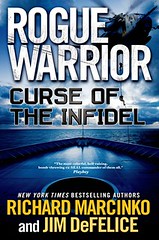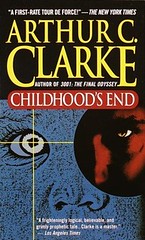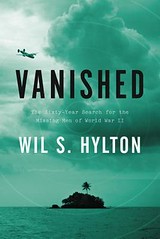“It was true that our hearts were swollen, our muscles were failing, our kidneys, stomachs, and other internal organs were not doing their jobs properly, our blood was too thick and ready to spawn embolisms, our red blood cells were doing without the oxygen they needed, and our brains were oxygen starved and running like an automobile with its last few dregs of gasoline in the tank. We were metaphorical inches from hypothermia—which has a wider range of terrible symptoms than merely going to sleep and freezing to death, not the least of which would be intemperate belligerence and a need to rip our clothes off as we froze—and literal inches from a 9,000-foot drop to our south side and a 10,000-foot drop a few more feet away to the north side. But for the moment, we were very happy.” — The Abominable, by Dan Simmons
 The Abominable
The Abominable
Dan Simmons
![]()
I’m not sure what attracts me, because it’s not a sport I would ever attempt, but I’m fascinated by non-fictional accounts of mountain climbing. Just in the past two years I’ve read two Everest books, Into Thin Air and Into the Silence; one book about a disastrous climb in the Peruvian Andes, Touching the Void; and one about climbing the North Face of the Eiger, The White Spider.
Dan Simmons’ The Abominable is fiction, a novel about a secret attempt to summit Everest one year after the failed Mallory/Irvine expedition of 1924. I heard a short interview with Simmons on NPR and immediately ordered the book from my local library. I wasn’t paying close attention and ordered the CD audio version by mistake. I’m certain it was a fabulous narration, but I don’t have a long commute and could never listen to more than 10 minutes’ worth at a time. After getting through just one of eleven CDs I took them back and re-ordered the actual book. There was a very long waiting list, but it finally came and I’m delighted I didn’t just give up on it.
Clearly, Simmons studied some of the same true accounts of Everest climbs I had read. His mountain climbing passages all ring true. If you’re interested in high altitude mountain climbing, have done your own research or know about it from your own experience, have read true accounts of Everest attempts, you too will be impressed with the verisimilitude of Simmons’ novel, especially the details of the 1924 George Mallory/Sandy Irvine summit attempt that form the backdrop to the novel’s fictional 1925 attempt.
Most of the novel feels true. The prologue, an account of an interview with an elderly mountain climber now living out his last days in hospice, was so utterly convincing I Googled the man’s name — Jake Perry — to see if he was based on a real person (he wasn’t).
Earlier I had read another Dan Simmons novel, The Terror, a fictionalized account of the Franklin Expedition of 1845, a failed attempt to find the Northwest Passage. In it, in addition to the known horrors the doomed crew must have experienced — scurvy, the loss of their ships, starvation, exposure, polar bear attacks — Simmons introduced a nightmarish supernatural threat. That is the case here with Simmons’ yetis, the abominable snowmen implied in the novel’s title (which also derives from some “abominable” photographs of a young Adolph Hitler).
As with Jake Perry, the fictional climber who purportedly writes this memoir, you can easily believe you’re reading the true, autobiographical account of a previously-unknown 1925 Everest attempt — until you come to the elements that make it a novel, that is. These elements stand out as being not possible, and you have to stretch your credulousness a bit to get past them.
One of those elements is a too-good-to-be-true woman, Reggie, who not only accompanies the four men and their Sherpa guides to the mountain, but climbs it with them, shouldering more than her share of the load, one of the strongest climbers in the group. Not that such women do not routinely climb Everest today; of course they do. But in the context of 1925, she is anachronistically out of place.
Another is the group of cartoonishly-evil German villains, all members of the nascent Nazi party.
And the last, of course, is the yeti, the abominable snowman. Yes, the yeti makes an appearance in this novel, an analog to the all-devouring white horror that gave me nightmares for weeks after reading Simmons’ earlier novel, The Terror.
But you don’t get to any of these jarring elements until you’re halfway into The Abominable, and by that point you’re well and truly hooked. Good job, Dan Simmons, you got me. I devoured your novel. You kept me well and truly entertained, on the edge of my seat all the way through.
 Curse of the Infidel (Rogue Warrior #18)
Curse of the Infidel (Rogue Warrior #18)
Richard Marcinko, Jim DeFelice
![]()
I knew of Commander Marcinko when I served with US Special Operations Command in 1987 and 1988. I never met the man himself, but I worked with several SEAL officers (many of them former SEAL team commanders, friends and colleagues of Cmdr Marcinko) and consequently heard plenty of scuttlebutt about the trouble Marcinko had gotten himself into.
During the second half of the 1980s special operations was riding high: a direct beneficiary of the 1986 Goldwater-Nichols Act, the darling of Presidents Reagan and George H. W. Bush, able to get anything it wanted when it came to budgets and procurement. Marcinko, the word was, had pushed even those liberal limits too far, and although he was allowed to retire was arrested shortly afterward. He wound up serving 21 months in a federal pen for defrauding the government.
On the other hand, he did found SEAL Team 6 (and later, the secretive Red Cell), and if there is another organization more highly admired within the US special operations community, I don’t know of it. Clearly, I have mixed feelings about the man. He was one of the best of the best; he also seems to have been a scoundrel.
Is he a writer? Are these books worth reading? It depends. If you’re a fan of he-man action and braggadocio, if you believe the colorful stories you’ve heard about special operations (and Navy SEALs in particular), if you dream of violent covert retribution against America’s enemies, you will love this book.
If you are less credulous, you will not. I know a bit about special ops, and as I’ve mentioned, worked with some of Marcinko’s contemporaries. I know the strict limits civilian and military commanders put on operators in the field. In short, I am less credulous. The notion that Marcinko’s Red Cell operation … the real one he ran back in the day, the fictional one he runs in the Rogue Warrior novels … operates with no constraints, has unlimited money and transportation assets at its disposal, doesn’t have to worry about rules of engagement or laws? None of this squares with my knowledge of special ops.
What about the plot? Marcinko crafts a reasonably complex plot for this novel, but he’s so focused on the action scenes he neglects large parts of the plot and winds up closing the novel by stepping in as godly narrator to wrap up loose ends.
What about the writing? Lazy and gimmicky. Marcinko’s disparaging name for the CIA is “Christians in Action.” It’s funny at first but he milks the joke dry, repeating it throughout the book. When he meets fellow Red Cell members or SEALs, mutual greetings are always an exchange of four-letter endearments (which Marcinko, surprisingly, is too dainty to spell out for the reader, leading me to utter a few four-letter endearments of my own). Every other sentence is written ironically and means the opposite of what it says: “The Saudi authorities welcomed me at the entrance of the interview suite” translates as “They beat me senseless and threw my unconscious body into a rat-infested interrogation cell.” Whenever Marcinko’s character Demo Dick is looking down the barrel of a terrorist’s AK-47, the cavalry magically appears to rescue him.
I could write a much longer list, but that’s enough to give you a taste. It’s instructive to read reviews of earlier Rogue Warrior novels. Other reviewers have tripped over the same writerly gimmicks, leading me to think Marcinko’s earlier novels are of a piece with this one.
Marcinko’s conservative politics peek out from time to time, but he doesn’t beat the reader over the head with them. He’s also careful to avoid overt racism … indeed his fictional Red Cell sidekicks are as diverse as can be … but Arabs? All bad, all villains.
I wanted to like this book. I’m a special operations groupie. Members of these elite units have done, and continue to do, extraordinary things. I’ve heard some amazing stories, and have enough insider knowledge to believe much of what I’ve heard. Marcinko’s stories probably incorporate some actual exploits and successes, but much of what he writes comes across as fantastic or at the very least highly embellished … not to mention bombastic and egotistical. When it comes to spreading the good word about military special operations, Commander Marcinko has done a service, I suppose. But I think his literary franchise has grown into some sort of self-serving enterprise, and as a writer I think he’s coasting.
 Cryptonomicon
Cryptonomicon
Neal Stephenson
![]()
This is my favorite Neal Stephenson science fiction novel to date. There are problems with it, but it’s an engrossing read from beginning to end. I’ll try to balance the bad with the good.
The bad: Stephenson doesn’t do women well. Worse yet, with the exception of the kinda sorta masculine Amazon fantasy characters Amy, who we get to know somewhat, and Glory, who we really don’t get to know at all, women are objects to ejaculate into (Neal’s word, not mine).
The in-between: as with Mary Poppins’ medicine, the core of this novel is a bitter bolus of math and cryptology, encapsulated within a sugar coating of rollicking adventure, wartime exploits, hidden treasure, memorable villains, and great male characters.
The good: rollicking adventure, wartime exploits, hidden treasure, memorable villains, and great male characters. The sugar coating is so effective, in fact, that I was not only able to swallow the bitter bolus of math and cryptology Stephenson forced down my throat, he had me convinced I was enjoying it! I will confess, though, that the academic appendix was too bitter for me, and I spat that part out.
If a woman had not recommended this book to me, I would have characterized Cryptonomicon as a man’s book. It would be more accurate to describe it as a manly book for brainiacs. My reaction to it was, as noted, mixed, but on the whole I loved it far more than I hated it.
 Childhood’s End
Childhood’s End
Arthur C. Clarke
![]()
A younger friend recently told me she was reading Childhood’s End for the first time. When I was a kid in the 1950s I read everything Arthur C. Clarke had written up to that time. When 2001: A Space Odyssey came out in 1968 and blew everyone away, I puffed my chest out and said “I’ve been reading Arthur C. Clarke all my life.” Sometime during the 1980s I read Clarke’s Rama books and experienced the same kind of wonder I felt when I first discovered science fiction. So when this young woman told me she was reading Clarke’s classic Childhood’s End, I had to read it again myself.
Huh. Apparently my tastes have changed. I still read science fiction, a lot of it in fact, but I’ve come to expect more in the way of characterization and story. I want to be able to relate to life as I might experience it in some alternate or possible future. I’m impatient with dry, airy explanations how mankind might evolve if it ever encounters an alien civilization. I want to know what it would be like if something like that were ever to happen. How it would feel. How it would affect ordinary men and women. How it might affect me, should it happen tomorrow.
Childhood’s End is more a manifesto than a novel. Clarke’s characters, at least in this early work, are wooden. They aren’t anyone I know. Moreover, Clarke comes across as preachy and naive. No human race I’ve ever been a part of would roll over and call invading aliens from space “overlords.” We’d fucking flip out, that’s what we’d do.
Remember the multiracial United Nations groupie types who crowded around the flying saucer in The Day the Earth Stood Still, calling for international peace and understanding? That’s the human cast of Childhood’s End, and no, you wouldn’t believe them either.
Yes, Childhood’s End contains Big Ideas and was the inspiration for later science fiction movie blockbusters like 2001 and Independence Day. That’s why I give it 2.5 stars: it’s undeniably a science fiction classic. As a novel, though, Childhood’s End is pedantic, academic, and dry, disconnected from reality in every possible way. I suspect I’m not the only older reader to come back to it and be disappointed.
 Year of Wonders
Year of Wonders
Geraldine Brooks
![]()
My book club selected this for our February read under the “historical fiction” category. Last year, under the same category, we read Hillary Mantel’s Wolf Hall, and everyone was blown away by it. Sadly, Year of Wonders doesn’t come close. I’m not even sure it’s historical fiction. Let me explain:
The narrator, Anna, is hopelessly out of time and context. She is not believable as an uneducated provincial village woman of the 17th century. Geraldine Brooks injects ancient nouns into Anna’s speech, but Anna’s thoughts, indeed her very way of thinking, are of this time, not of that time.
Early in my reading I began to sense the possibility that Brooks was going to turn her story into a bodice-ripping romance. I told myself if she went there I’d throw the book across the room and scold the other members of our book club for selecting trash. When Brooks did indeed go there I was within five or six pages of finishing the damn book, so I held off until the last page. Then I threw it. The scolding will occur at our next meeting.
Why would I give a book that pissed me off two stars? Because it’s based on historical events and, at least as far as what is known to have happened to the villagers during their plague year, the author didn’t embellish the horror of events. Because the author can spell and string a story together. Because I don’t want to gratuitously insult anyone who liked Year of Wonders, any more than I would insult someone who goes gaga over ponies or kittens.
I rated Hillary Mantel’s Wolf Hall & Bring Up the Bodies four stars each. In giving Geraldine Brooks’ Year of Wonders two stars, you might think I’m saying Brooks is like Mantel, only not as good. That’s not what I mean to say at all. The novels do not compare. Even though Brooks’ novel is based on true events and one can learn a little about how people understood disease and tried to deal with it several hundred years ago, I can’t consider Year of Wonders historical fiction. Not just because of the Harlequin romance ending, but because the main character is not believable. Mantel’s Thomas Cromwell is fully believable, a man of his time and place in society. Anna is more like one of Dr. Who’s sidekicks, mistakenly left behind in an English village in the 17th century.
 Vanished: The Sixty-Year Search for the Missing Men of World War II
Vanished: The Sixty-Year Search for the Missing Men of World War II
Wil S. Hylton
![]()
I heard an interview with the author on NPR. I’m interested in the Pacific bombing campaigns of WWII, and had read Laura Hillenbrand’s Unbroken last year, so I knew right away I’d want to read this one too. As soon as I could get to my desktop computer I ran a Google search for “Will Hilton.” I came up empty-handed. Fortunately, I remembered the book’s title, which at least is spelled the way it sounds, and was able to order a copy from my local library (sorry, Wil, just having a little fun at your expense).
I’m no expert on what passes for popular writing about WWII in the Pacific, but my impression is that the Army Air Corps’ bombing campaign in that theater has been less covered than the fighter and attack campaigns flown by the Navy. True, much has been written about the B-29 bombing of the Japanese homeland, but comparatively little about the island bombing raids conducted by B-24s and their crews.
I was also drawn in by the detective and forensic aspects of Hylton’s story, the finding of wrecks missing for 60+ years, the determination of what had happened to the missing crewmen from those wrecks.
I was delighted to find a book that helped fill in some of the blanks in my knowledge of the B-24 campaigns, and when it comes to crafting a suspenseful story about finding lost planes and crews — a story that would make a damn fine thriller novel, no less — Hylton delivers. There are even villains, and boy are they ever: the Japanese and their kempai Gestapo.
I wish Hylton had included a few more photos. That’s my only criticism.
I could not put this book down. I devoured it. I want more.